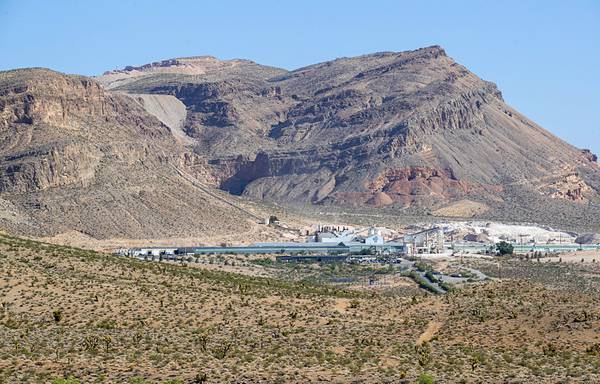
By Hillary Davis
A housing development proposed for near Red Rock Canyon that has been met with resistance from conservationists for nearly two decades because it would build-up against the federally protected, popular outdoor recreation area is closer to becoming a reality.
The Clark County Commission unanimously approved a permit earlier this month for developer Gypsum Resources to move forward with the first phase of its long-embattled 2,000-acre master-planned community on Blue Diamond Hill.
Though it won’t break ground on homes in the immediate future, Gypsum Resources now has the go-ahead to design roads and utilities for 280 luxury homes on 563 acres on the site of a century-old gypsum mine near Blue Diamond Hill.
Conservationists argue that the county gave its approval against its own codes governing road access and how lots and buildings are arranged in the area.
“With the canyon being such a precious visual and recreational resource for Southern Nevadans, the commission should deny or hold the permit until all information is available and the request is in compliance with the law,” said Valarie Kuschel of the nonprofit Save Red Rock, which seeks to keep heavy development away from the canyon area.
The full development, envisioned as coming in five phases and totaling as many as 5,000 homes, has been floating before the Clark County Commission since 2003 — but also has been mired in lawsuits under fierce opposition from residents and government officials alike.
Kuschel said Red Rock was so beloved, “almost revered,” that any approvals for development in the vicinity needed to be beyond reproach.
Ron Krater, a planner and representative of landowner Gypsum Resources, called the subdivision about 20 miles southwest of the Strip a “class-defining residential community” that met conditions for approval.
He referred to an assessment by Clark County Deputy District Attorney Rob Warhola, who said the code that conservationists cited did not apply here. And at a density of one home per two acres, the project satisfies the area’s rural zoning standards.
A federal lawsuit Gypsum Resources filed against Clark County in 2019 is still pending, claiming violation of due process, breach of contract over a settlement in a prior fight to build at Blue Diamond Hill, and bias standing in the way of the development. Still, county commissioners approved the landowner’s request Aug. 4 on the phase-one subdivision.
Before the commission’s vote, several members of Save Red Rock kept up the pressure.
Heather Fisher, Save Red Rock’s president, said Gypsum Resources didn’t have legal access to the project site. A road serving the mine, the only way currently into the site, is on Bureau of Land Management property.
Organization member Pauline Van Betten got into details of the Red Rock Overlay District, the development code borne of an even older attempt to add to Las Vegas suburbia atop Blue Diamond Hill, and the settlement the county reached with Gypsum Resources in 2010 after the company sued over the overlay district.
The settlement carved out exceptions where Gypsum could submit so-called “major applications” as long as they weren’t connected to State Route 159, a state-designated scenic byway that turns into a stretch of the loop road through the heart of Red Rock. Major projects also have to adhere to other rules: lots can’t be clustered too close together, and houses have to be built at a minimum distance from property lines.
Van Betten says clustering and building placement leaving too-tight yard spaces are all present here. At the same time, they weren’t part of an allowed “major application.”
“I am concerned that this application is not ripe for decision,” Fisher said. “We don’t want to waste taxpayer money and staff time on an application that does not comply with Clark County code.”
The commission votes included a yes from Justin Jones, an attorney who represents the area near Red Rock and who served as a lawyer for Save Red Rock when the group sued Clark County over the development in 2016. Save Red Rock dropped the suit in 2018, before Jones took office.
Upon his election, the state government ethics board said Jones could vote on zoning matters involving Gypsum Resources. Gypsum has since singled out Jones for personal hostility toward its owner Jim Rhodes, which Jones has denied.
Jones publicly asked Warhola whether he had to abstain for this most recent vote, and the county’s attorney said no. Jones had no further comment.
Commissioner Tick Segerblom said he voted yes because the application complied with zoning rules.
“It sounds to me like there’s so many issues going forward that were not really addressed at this point,” he said. “I don’t see how they could ever do it … but just if the very basic concept of the land use matches what they’ve asked for then I think at this point we have to vote in favor.”
Krater acknowledged that Gypsum Resources would need to get road access from the BLM. Warhola said a paved road wasn’t necessary at this stage in the process, though.
Krater said opponents took the code restrictions out of context, and that the project property was exempt anyway.
The subdivision will still leave open space, he said. The average lot will be roughly half an acre. The smallest will be about a quarter of an acre.
Gypsum Resources has been trying to find a higher use for land that has been degraded by mineral extraction for almost 100 years, Krater said.
Warhola told county commissioners that the code was meant to preserve natural settings and mined land was no longer natural. Krater agreed.
“The reality is, it’s a strip mine,” he said.

















